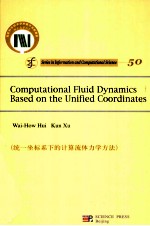

统一坐标系下的计算流体力学 英文版PDF电子书下载
- 电子书积分:9 积分如何计算积分?
- 作 者:许为厚,徐昆著
- 出 版 社:北京:科学出版社
- 出版年份:2011
- ISBN:9787030323194
- 页数:190 页
Chapter 1 Introduction 1
1.1 CFD as Numerical Solution to Nonlinear Hyperbolic PDEs 1
1.2 Role of Coordinates in CFD 2
1.3 Outline of the Book 5
References 6
Chapter 2 Derivation of Conservation Law Equations 9
2.1 Fluid as a Continuum 9
2.2 Derivation of Conservation Law Equations in Fixed Coordinates 10
2.3 Conservation Law Equations in Moving Coordinates 14
2.4 Integral Equations versus Partial Differential Equations 14
2.5 The Entropy Condition for Inviscid Flow Computation 17
References 18
Chapter 3 Review of Eulerian Computation for 1-D Inviscid Flow 19
3.1 Flow Discontinuities and Rankine-Hugoniot Conditions 19
3.2 Classification of Flow Discontinuities 21
3.3 Riemann Problem and its Solution 26
3.4 Preliminary Considerations of Numerical Computation 34
3.5 Godunov Scheme 35
3.6 High Resolution Schemes and Limiters 38
3.7 Defects of Eulerian Computation 39
References 40
Chapter 4 1-D Flow Computation Using the Unified Coordinates 43
4.1 Gas Dynamics Equations Based on the Unified Coordinates 43
4.2 Shock-Adaptive Godunov Scheme 45
4.3 The Use of Entropy Conservation Law for Smooth Flow Computation 47
4.4 The Unified Computer Code 48
4.5 Cure of Defects of Eulerian and Lagrangian Computation by the UC Method 52
4.6 Conclusions 66
References 66
Chapter 5 Comments on Current Methods for Multi-Dimensional Flow Computation 69
5.1 Eulerian Computation 69
5.2 Lagrangian Computation 71
5.3 The ALE Computation 73
5.4 Moving Mesh Methods 73
5.5 Optimal Coordinates 74
References 75
Chapter 6 The Unified Coordinates Formulation of CFD 79
6.1 Hui Transformation 79
6.2 Geometric Conservation Laws 80
6.3 Derivation of Governing Equations in Conservation Form 80
References 85
Chapter 7 Properties of the Unified Coordinates 87
7.1 Relation to Eulerian Computation 87
7.2 Relation to Classical Lagrangian Coordinates 87
7.3 Relation to Arbitrary-Lagrangian-Eulerian Computation 88
7.4 Contact Resolution 89
7.5 Mesh Orthogonality 89
7.6 Unified Coordinates for Steady Flow 91
7.7 Effects of Mesh Movement on the Flow 92
7.8 Relation to Other Moving Mesh Methods 92
7.9 Relation to Mesh Generation and the Level-Set Function Method 94
References 94
Chapter 8 Lagrangian Gas Dynamics 97
8.1 Lagrangian Gas Dynamics Equations 97
8.2 Weak Hyperbolicity 98
8.3 Non-Equivalency of Lagrangian and Eularian Formulation 99
References 100
Chapter 9 Steady 2-D and 3-D Supersonic Flow 101
9.1 The Unified Coordinates for Steady Flow 101
9.2 Euler Equations in the Unified Coordinates 102
9.3 The Space-Marching Computation 104
9.4 Examples 105
9.5 3-D Flow 111
References 114
Chapter 10 Unsteady 2-D and 3-D Flow Computation 117
10.1 Summary of Solution to the 2-D Euler Equations Using the Unified Coordinates 117
10.2 Computation Procedure 119
10.3 Examples 122
References 125
Chapter 11 Viscous Flow Computation Using Navier-Stokes Equations 127
11.1 Navier-Stokes Equations in the Unified Coordinates 127
11.2 The Angle-preserving Equation 130
11.3 Advantages of the g-equation Over the h-equation 131
11.4 Boundary Condition and Movement of Boundary Cells 133
11.5 Solution Strategies 134
11.6 Test Examples:Shock/Boundary Flow Interaction and Shock/Shock Interaction 138
References 145
Chapter 12 Applications of the Unified Coordinates to Kinetic Theory 147
12.1 Brief Introduction of Gas-Kinetic Theory 147
12.2 Gas-Kinetic BGK Model Under the Unified Coordinate Transformation 152
12.3 Numerical BGK-NS Scheme in a Moving Mesh System 153
12.4 Numerical Procedure 157
12.5 Numerical Examples 158
12.6 Conclusion 168
References 168
Chapter 13 Summary 171
Appendix A Riemann Problem for 1-D Flow in the Unified Coordinate 173
Appendix B Computer Code for 1-D Flow in the Unified Coordinate 177
- 《流体力学》张扬军,彭杰,诸葛伟林编著 2019
- 《工程静力学》王科盛主编 2019
- 《空气动力学 7 飘浮的秘密》(加)克里斯·费里著 2019
- 《材料力学 上》杨在林,杨丽红主编 2011
- 《流体力学与传热学》潘小勇编著 2019
- 《材料力学 第2版》严圣平,马占国 2018
- 《海洋油气计算流体力学》朱红钧编 2016
- 《临近空间高超声速飞行器计算空气动力学》艾邦成著 2020
- 《写给孩子的趣味力学》(俄)雅科夫·伊西达洛维奇·别莱利曼著 2019
- 《工程力学》伍春发,张凤,高文秀主编 2019
- 《指向核心素养 北京十一学校名师教学设计 英语 七年级 上 配人教版》周志英总主编 2019
- 《《走近科学》精选丛书 中国UFO悬案调查》郭之文 2019
- 《北京生态环境保护》《北京环境保护丛书》编委会编著 2018
- 《中医骨伤科学》赵文海,张俐,温建民著 2017
- 《美国小学分级阅读 二级D 地球科学&物质科学》本书编委会 2016
- 《指向核心素养 北京十一学校名师教学设计 英语 九年级 上 配人教版》周志英总主编 2019
- 《强磁场下的基础科学问题》中国科学院编 2020
- 《小牛顿科学故事馆 进化论的故事》小牛顿科学教育公司编辑团队 2018
- 《小牛顿科学故事馆 医学的故事》小牛顿科学教育公司编辑团队 2018
- 《高等院校旅游专业系列教材 旅游企业岗位培训系列教材 新编北京导游英语》杨昆,鄢莉,谭明华 2019
